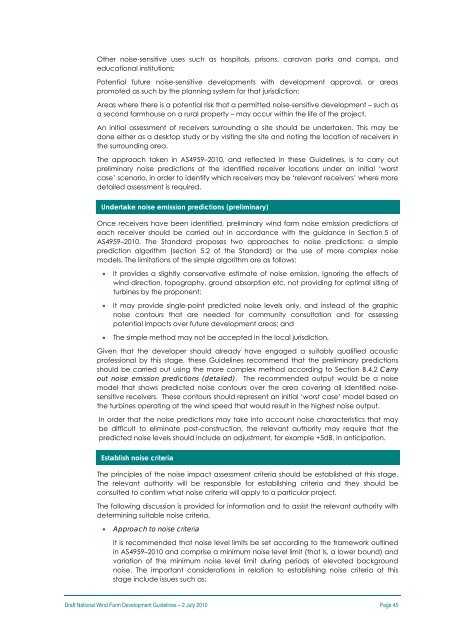Draft National Wind Farm Development Guidelines - July 2010
Draft National Wind Farm Development Guidelines - July 2010
Draft National Wind Farm Development Guidelines - July 2010
Create successful ePaper yourself
Turn your PDF publications into a flip-book with our unique Google optimized e-Paper software.
Other noise-sensitive uses such as hospitals, prisons, caravan parks and camps, and<br />
educational institutions;<br />
Potential future noise-sensitive developments with development approval, or areas<br />
promoted as such by the planning system for that jurisdiction;<br />
Areas where there is a potential risk that a permitted noise-sensitive development – such as<br />
a second farmhouse on a rural property – may occur within the life of the project.<br />
An initial assessment of receivers surrounding a site should be undertaken. This may be<br />
done either as a desktop study or by visiting the site and noting the location of receivers in<br />
the surrounding area.<br />
The approach taken in AS4959–<strong>2010</strong>, and reflected in these <strong>Guidelines</strong>, is to carry out<br />
preliminary noise predictions at the identified receiver locations under an initial ‘worst<br />
case’ scenario, in order to identify which receivers may be ‘relevant receivers’ where more<br />
detailed assessment is required.<br />
Undertake noise emission predictions (preliminary)<br />
Once receivers have been identified, preliminary wind farm noise emission predictions at<br />
each receiver should be carried out in accordance with the guidance in Section 5 of<br />
AS4959–<strong>2010</strong>. The Standard proposes two approaches to noise predictions: a simple<br />
prediction algorithm (section 5.2 of the Standard) or the use of more complex noise<br />
models. The limitations of the simple algorithm are as follows:<br />
• It provides a slightly conservative estimate of noise emission, ignoring the effects of<br />
wind direction, topography, ground absorption etc, not providing for optimal siting of<br />
turbines by the proponent;<br />
• It may provide single-point predicted noise levels only, and instead of the graphic<br />
noise contours that are needed for community consultation and for assessing<br />
potential impacts over future development areas; and<br />
• The simple method may not be accepted in the local jurisdiction.<br />
Given that the developer should already have engaged a suitably qualified acoustic<br />
professional by this stage, these <strong>Guidelines</strong> recommend that the preliminary predictions<br />
should be carried out using the more complex method according to Section B.4.2 Carry<br />
out noise emission predictions (detailed). The recommended output would be a noise<br />
model that shows predicted noise contours over the area covering all identified noisesensitive<br />
receivers. These contours should represent an initial ‘worst case’ model based on<br />
the turbines operating at the wind speed that would result in the highest noise output.<br />
In order that the noise predictions may take into account noise characteristics that may<br />
be difficult to eliminate post-construction, the relevant authority may require that the<br />
predicted noise levels should include an adjustment, for example +5dB, in anticipation.<br />
Establish noise criteria<br />
The principles of the noise impact assessment criteria should be established at this stage.<br />
The relevant authority will be responsible for establishing criteria and they should be<br />
consulted to confirm what noise criteria will apply to a particular project.<br />
The following discussion is provided for information and to assist the relevant authority with<br />
determining suitable noise criteria.<br />
• Approach to noise criteria<br />
It is recommended that noise level limits be set according to the framework outlined<br />
in AS4959–<strong>2010</strong> and comprise a minimum noise level limit (that is, a lower bound) and<br />
variation of the minimum noise level limit during periods of elevated background<br />
noise. The important considerations in relation to establishing noise criteria at this<br />
stage include issues such as:<br />
<strong>Draft</strong> <strong>National</strong> <strong>Wind</strong> <strong>Farm</strong> <strong>Development</strong> <strong>Guidelines</strong> – 2 <strong>July</strong> <strong>2010</strong> Page 45
















